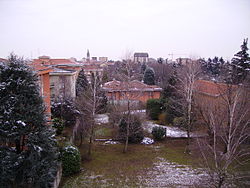- Muggiò
-
Muggiò — Comune — Comune di Muggiò Muggiò 
Coat of armsLocation of Muggiò in Italy Coordinates: 45°36′N 9°14′E / 45.6°N 9.233°E Country Italy Region Lombardy Province Monza and Brianza (MB) Frazioni Taccona Area – Total 5.5 km2 (2.1 sq mi) Elevation 186 m (610 ft) Population (31 December 2009) – Total 23,362 – Density 4,247.6/km2 (11,001.3/sq mi) Demonym Muggioresi Time zone CET (UTC+1) – Summer (DST) CEST (UTC+2) Postal code 20835 Dialing code 039 Website Official website Muggiò is a city (municipality) in the Province of Monza and Brianza in the Italian region Lombardy, located about 15 km northeast of Milan. As of 2009, it had a population of 23,500 and an area of 5.5 km².[1] It received the honorary title of city with a presidential decree on September 27, 1992. The municipality of Muggiò contains the frazione (subdivision) Taccona. Muggiò borders the following municipalities: Lissone, Desio, Monza, Nova Milanese, Cinisello Balsamo.
Contents
Historical Buildings
Villa Casati Stampa di Soncino
Villa Casati Stampa, which is now the town hall of Muggiò, is a neoclassical building designed 1798 by the famous Austrian architect Leopold Pollack. The house was built on a pre-existing sixteenth-century structure, At the centre of one of the longer sides of the villa Pollack inserted a cylindrical section with an elliptical base jutting out into the park; opposite this feature, but on the other side, he placed the entrance portico. The villa was crowned by an extensive park of more than twenty thousand square metres (nearly five acres), designed as an English landscaped garden, great attention being paid to a complementary relationship with the architectural design of the house itself. Today, the park has been transformed and laid out as a sports ground.
The Mausoleum of Casati Stampa di Soncino
The Mausoleum of Casati Stampa Soncino is a plant commemorative monument that features and focuses on the urban cemetery Muggiò (Monza and Brianza) since 1830. Inside, a large rectangular area is then given to the family Casati, an ancient aristocratic Milanese origin Lombard, whose genealogy is proven by 1030. In the mausoleum, a work of art, many buried mortal remains. Here are the different graves and kept a crypt surmounted by a temple of classical greek-order Doric, to protect an altar cross with wood.
Among others buried there:
Teresa Casati (1787 - 1830) Federico Confalonieri (1785 - 1846) Gabrio Casati (1798 - 1873) Angelo Casati (1802 - 1846) Camillo Casati (1805 - 1869) Rinaldo Casati (1844 - 1898) Camillo Casati Stampa of Soncino (1877 - 1946) Alessandro Casati (1881 - 1955) Alfonso Casati (1918 - 1944) Camillo Casati (1927 - 1970) and Anna Fallarino, Drommi, Casati Stampa of Soncino (1929 - 1970), known to chronicle the homicide in Rome.
Saints Peter and Paul Cathedral
The sacred building devoted to the Saints Peter and Paul rises in lombardo-Gothic forms, on the central area of an ex Barnabita College (already the seventeenth century residence of the accounts Porro, maxima lands owners of Muggiò in that epoch), on plan of the famous architects Milanese, Angelo Savoldi and Giambattista Borsani, that they were inspired to the Basilica of Sant'Andrea in Vercelli (1219-1227). Few know that the construction, from a consecrated century (12 December 1897). The laying of the his first stone goes up again at 23 June 1895, witness of the event, beyond to the Archbishop from Milan, S.E. the Card. Carlo Andrea Ferrari (1850-1921). The bell tower proportionate and in perfect style with the rest of the constructions rise between the 1920 and the 1922. The principal façade comes completed in the respect of the ancient plan (1894) only in the 1968; tripartite, this has stayed all dressed again in cooked you with elements in trachite-travertino and enriched with icons tie to the life of the two Apostles. In the presbytery, two monumental frescos "the Delivery of the keys to St. Pietro" and "the Preaching of St. Paolo" dated 1940, work of the contemporary Pietro Cortellezzi, diploma recipient to the Academy of Brera, known in artistic field for have taken part to important exposures like the biennal exhibition from Venice and the Triennale from Milan. The Cathedral of Muggiò a most beautiful ecclesiastical constructions from Lombardy.
References
External links
Lombardy · Comuni of the Province of Monza and Brianza Agrate Brianza · Aicurzio · Albiate · Arcore · Barlassina · Bellusco · Bernareggio · Besana in Brianza · Biassono · Bovisio-Masciago · Briosco · Brugherio · Burago di Molgora · Busnago · Camparada · Caponago · Carate Brianza · Carnate · Cavenago di Brianza · Ceriano Laghetto · Cesano Maderno · Cogliate · Concorezzo · Cornate d'Adda · Correzzana · Desio · Giussano · Lazzate · Lentate sul Seveso · Lesmo · Limbiate · Lissone · Macherio · Meda · Mezzago · Misinto · Monza · Muggiò · Nova Milanese · Ornago · Renate · Roncello · Ronco Briantino · Seregno · Seveso · Sovico · Sulbiate · Triuggio · Usmate Velate · Varedo · Vedano al Lambro · Veduggio con Colzano · Verano Brianza · Villasanta · VimercateCategories:- Province of Milan geography stubs
- Cities and towns in Lombardy
- Communes of the Province of Monza and Brianza
Wikimedia Foundation. 2010.


